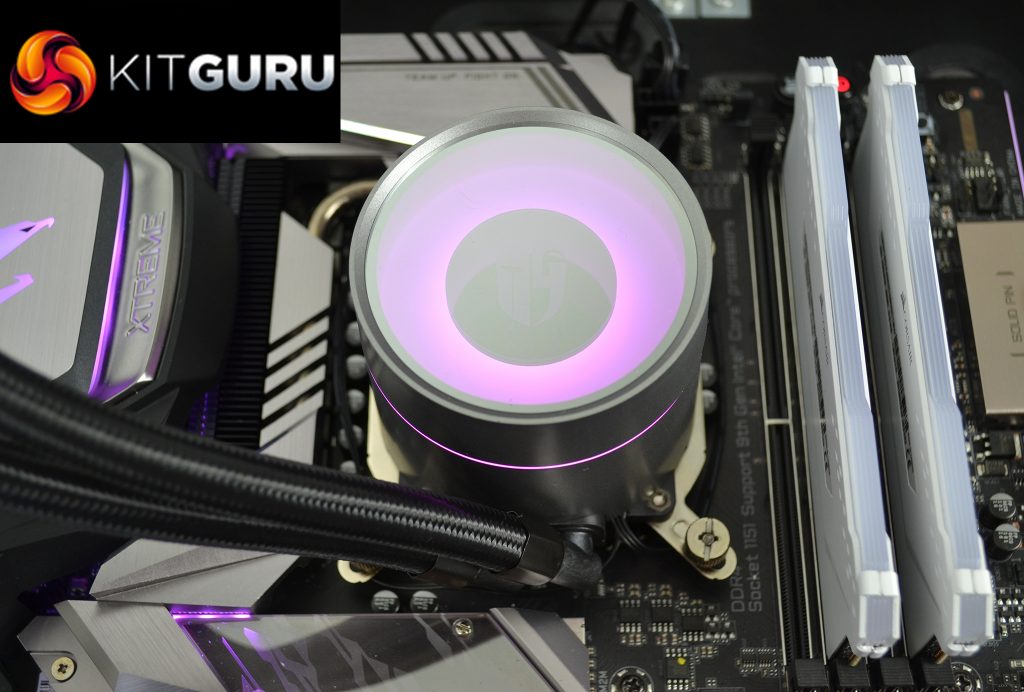In terms of value, the Deepcool Castle 280EX is an excellent proposition. With a launch price matching the smaller Castle 240EX, the price to performance ratio is one of the best on the market, perhaps only topped by the Arctic Liquid Freezer II, and for those users who want some form of RGB lighting, the Castle 280EX may be the better option for them.
With its RGB lighting zone integrated into the top of the CPU block, the Castle 280EX can be customised and controlled either in synchronisation with the motherboard via a 3-pin 5v ARGB header, or by using the simple RGB lighting hub that Deepcool provides. For even further customisation, the top of the CPU block is removable and the GamerStorm logo plate can be rotated or swapped out for a blank that could be personalised with the user's own logo.
Deepcool has also crafted a balanced blend of understated looks with the relatively plain looking all-black fans and radiator pairing, which is enhanced by the single CPU block RGB lighting zone. For me, the balance is just right. However, if you prefer a more stealthy look to the system, the RGB lighting can be disabled or just simply left disconnected.
CPU socket support is extensive with the Castle EX series too. The coolers installation hardware covers all current mainstream desktop platforms from Intel and AMD, including the new Intel LGA1200 socket and even the high-end desktop AMD TR4/TRX40 Threadripper platform, which is great if you plan to upgrade in the future and bring the Castle 280EX to the new system.
Installation of the Castle 280EX is also rather simple, there is some initial preparation of the motherboard backplate and upper mounting brackets to fit the CPU block, nevertheless, this is explained in detail in the installation manual and all the parts are easily distinguishable. On our test system, the installation only takes approximately 15 minutes and we expect even the most novice PC builder will find the process quite easy to complete.
Another feature of the Castle 280EX I am impressed with is the use of standard cables connections. There are no proprietary fan headers or RGB connections, so everything just plugs into the motherboard. Fan speed can easily be configured in the motherboard BIOS, RGB lighting will synchronise perfectly and the final product looks neat and tidy since there are no additional fan controllers or RGB hubs required to complete the installation.
Thermal performance of the Deepcool Castle 280EX is also very impressive. Granted, it's not the absolute best we have ever tested, but it is right up there with other 280mm AIO coolers of a higher price. Not only is the thermal performance solid with the fans and pump all running at maximum RPM, but when noise is normalised, the Castle 280EX still keeps up with some of the higher-priced closed-loop coolers, which again highlights its excellent price to performance ratio.
Taken as a whole, the Castle 280EX is an excellent all-round package. The combination of the minimalistic appearance to the fan design and the hint of RGB lighting works really well, I would certainly recommend adding the Castle 280EX to your CPU cooler shortlist for future system builds, especially for those with a tight budget but looking for maximum thermal performance.
The Deepcool Castle 280EX has an MSRP £119.99, and should be available now.
Pros
- Excellent value for money.
- Extensive CPU socket support.
- Understated appearance with a hint of RGB.
- Easy installation.
- Solid thermal performance.
Cons
- Pump housing looks bulky.
KitGuru says: The Deepcool Castle 280EX is an excellent 280mm AIO cooler. The combination of solid thermal performance and relatively affordable pricing compared with other coolers of this size means it's difficult to ignore when planning a future system build.
 KitGuru KitGuru.net – Tech News | Hardware News | Hardware Reviews | IOS | Mobile | Gaming | Graphics Cards
KitGuru KitGuru.net – Tech News | Hardware News | Hardware Reviews | IOS | Mobile | Gaming | Graphics Cards




